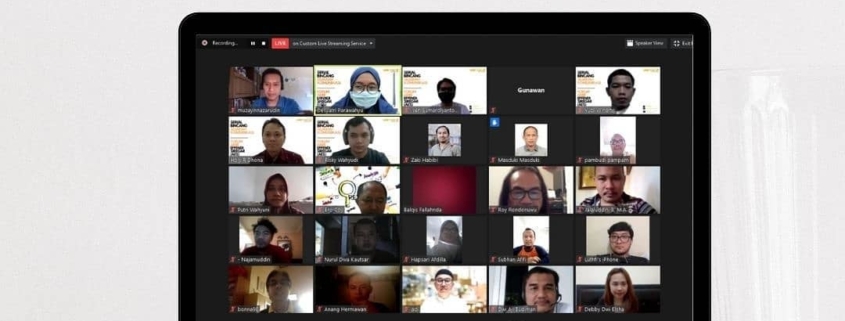AES Forum #11: Semiotics History on Communication Studies in Indonesia
We have often heard about semiotics as a method of visual text analysis. Names like Roland Barthes, Pierce, or Saussure are no stranger to communicative friends. Semiotics as an analytical scalpel has even become a trend in analysis around the 2000s as seen from the existence of several compulsory courses on several campuses in Indonesia.
However, Muzayin Nazaruddin, one of the lecturers at the Islamic University Communication Science who also seriously studied semiotics with a master and took a Ph. D at the University of Tartu, wants to see in a bigger picture the tendency to use methods that are common in Indonesia. Semiotics should serve as a paradigm, not a text analysis tool.
At the Amir Effendi Siregar (AES) Forum on September 26, 2020, Muzayin showed a tendency to use the same semiotic tradition. As if it has become an example of how to operate the semiotic method in analyzing films or images. “That’s not wrong, but it’s boring.”
Muzayin gave an example of a study that is commonly carried out by students and, unfortunately, also carried out by researchers. For example, research looks at what symbols appear in certain films or media. What is the meaning contained. For example, there are students researching patriotism in films. However, if we reflect on it, it turns out that he did not contribute anything to the development of the concept of patriotism.
In research prevalence using semiotics, for example, there is also a common sense which is useless. “For example, we analyze a photo of a woman with a hijab, detailed analysis, we analyze the hijab, the background, what she is wearing, the analysis is complicated. The denotation and connotation are like this. Then at the end, this conclusion concludes that this woman is Muslim,” Muzayin explained an example of semiotic research which is common in Indonesia. “It looks like this is cool, the thesis is thick, but this is sad, because to say that a Muslim woman wearing a hijab does not have to use a semiotic. High school student also know that the hijab is a marker of a Muslim. This is where I often see semiotic research failing,” said Muzayin exemplifying more details. This ultimately makes semiotics studies boring, stagnant, and says nothing and does not contribute,” Muzayin said further.
How is the actual history of semiotics studies in Indonesia?
The development of semiotics studies in Indonesia can be seen for example in the 1990s. “In the 1990s, student study groups studied semiotics not from lecture texts. Then according to Emmanuel Subangun said that in 1992 the Circle of Semiotic Enthusiasts in Jakarta was established,” said Muzayin. This is quite encouraging, according to him.
Returning to the tendency of semiotics to be a text analysis tool rather than a paradigm. When Semiotics is seen as a paradigm, it does not narrow it just as analytical methods. The semiotic paradigm allows researchers to see every event, phenomenon, media, and natural phenomenon with a semiotic perspective. For example, at Tartu University, where Muzayin took his doctoral program in Semiotics, there were various studies based on semiotics, such as Culture Semiotics, zoo semiotic, there is even something that is not yet common in Indonesia which is called bio-semiotic in Tartu.
For semiotics, communication is the central point for understanding culture, said Muzayin. “This is especially for cultural semiotics,” Muzayin explained. As for Biosemiotics, Communication is a fundamental concept to understand nature. Muzayin continued, even for ecosemiotics, communication is central to understanding the dynamics relations of culture-nature.
“At the animal and plant level, even semiotics is understood as a communication between the two to see the semiosis process,” Muzayin added. This is a perspective that we need to understand together.
Semiotic analysis with a micro analysis model is to see the unit of analysis in detail in the film: break it down, then see the signs in the scene, then translate into denotation, index, symbol connotations, etc.
In fact there are other ways, for example macro analysis by viewing the film, by relating various phenomena or the context of the film being made and then analyzed. “How do we see a film as a sign that is present in a certain sign system and then interpreted as a sign,” Muzayin explained.




